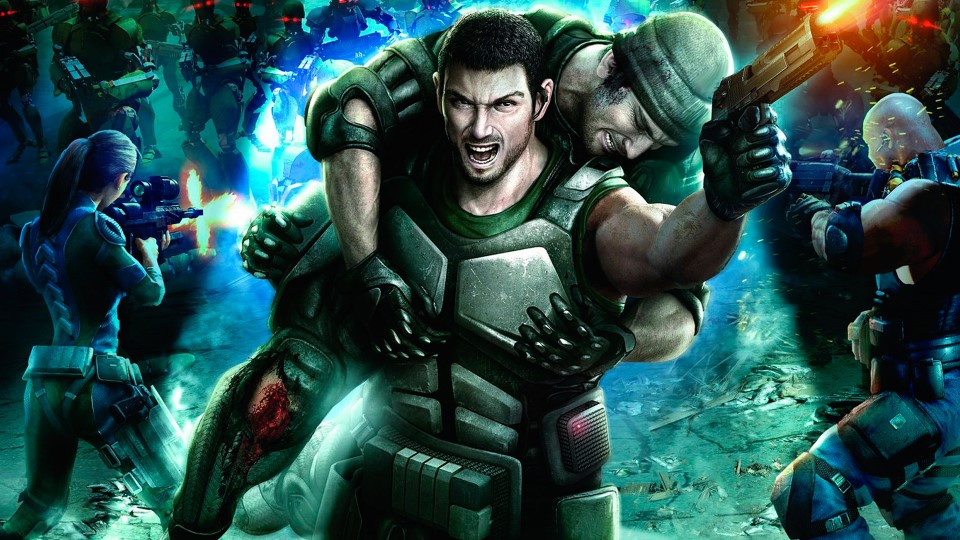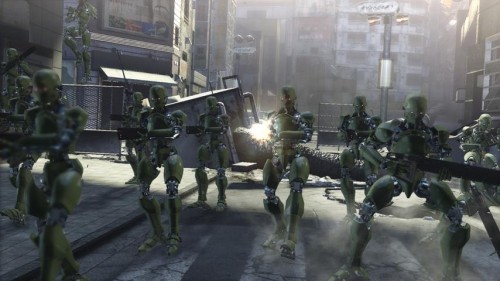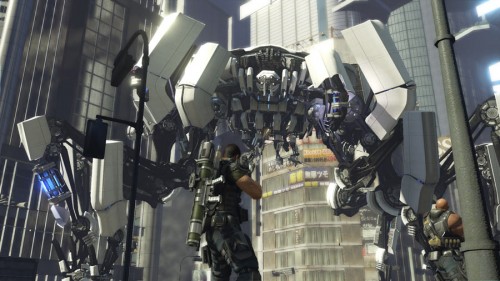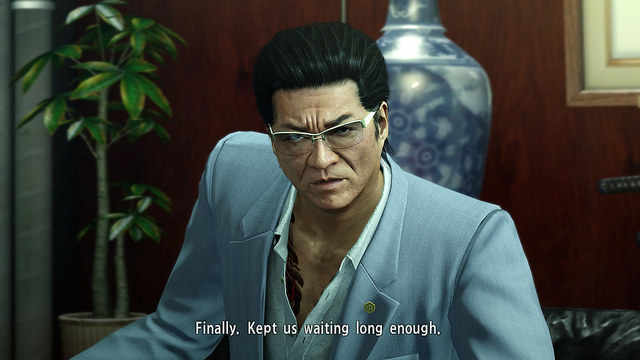
The third-person shooter has always been seen as an inherently Western genre, featuring crazily buff men shooting and blowing things up in ways that would make Michael Bay weep with joy. Lately however, Japan has been trying their hand at making such games, giving players titles such as Vanquish, the Earth Defense Forceseries and Shadows of the Damned. Binary Domain is the latest game to break the mould and it proves to be a great gaming experience with a couple of neat touches to separate it from the pack. Binary Domain is developed by Team CS1, the team behind the current-gen Yakuza games. If you’ve ever played any of the Yakuza games, you may expect something a bit deeper than that of your standard shooter. Thankfully, Binary Domain delivers on this count, featuring a rather ethically complex and emotionally moving tale. You play as Dan Marshall, an agent in the Rust Crew, who is tasked with infiltrating Tokyo and eliminating a robotic threat. As the plot progresses, the narrative starts to play out like I, Robot and The Second Renaissance rather than that of a typical action flick. You see, it’s also up to Dan and his squad to investigate Hollow Children, robots who look like and have human emotions, to the point of being unable to recognise that they are robots themselves.  Aside from a surprisingly deep story, Binary Domain also excels in presenting your squad mates as likeable, realistic characters. While the notion of feeling emotionally connected to characters in a fast-paced action game may be laughable, it starts to make more sense when you take two of the game’s major elements into account: the Consequence system and being able to issue commands to your team mates. The Consequence system is all about how much your squad trusts you, which can affect certain cutscenes and outcomes during battle. For example, accidentally shoot your team mate too often and his/her trust will decrease, which means that they are less likely to obey your commands. It’s fairly easy to gain trust however, as there are plenty of dialogue opportunities that allow you to do so, and doing well in battle will impress your squad too. What is unexpected is how much thought has been put into this system, and there are some unforeseen moments where characters will react positively or negatively in ways that are frighteningly lifelike. Similarly, the command system allows you to not only issue tactical commands to your squad mates during battle, but also to talk to them during the more quiet periods of the game. The neat thing about this system is that it supports both the controller and a headset, meaning that you can feel like you are actually speaking to them. Playing with a headset opens up loads more possibilities, giving you the ability to pull off more complicated tactics and consequently, feel more like you’re working as a team. However, my time with using voice recognition was brief and it didn’t always give me the greatest results; occasionally the game would pick up my breathing as swear words, which would result in my team mates wondering what my problem was, and sometimes it wouldn’t pick my words up at all.
Aside from a surprisingly deep story, Binary Domain also excels in presenting your squad mates as likeable, realistic characters. While the notion of feeling emotionally connected to characters in a fast-paced action game may be laughable, it starts to make more sense when you take two of the game’s major elements into account: the Consequence system and being able to issue commands to your team mates. The Consequence system is all about how much your squad trusts you, which can affect certain cutscenes and outcomes during battle. For example, accidentally shoot your team mate too often and his/her trust will decrease, which means that they are less likely to obey your commands. It’s fairly easy to gain trust however, as there are plenty of dialogue opportunities that allow you to do so, and doing well in battle will impress your squad too. What is unexpected is how much thought has been put into this system, and there are some unforeseen moments where characters will react positively or negatively in ways that are frighteningly lifelike. Similarly, the command system allows you to not only issue tactical commands to your squad mates during battle, but also to talk to them during the more quiet periods of the game. The neat thing about this system is that it supports both the controller and a headset, meaning that you can feel like you are actually speaking to them. Playing with a headset opens up loads more possibilities, giving you the ability to pull off more complicated tactics and consequently, feel more like you’re working as a team. However, my time with using voice recognition was brief and it didn’t always give me the greatest results; occasionally the game would pick up my breathing as swear words, which would result in my team mates wondering what my problem was, and sometimes it wouldn’t pick my words up at all.  It’s safe to say that if neither the Consequence nor the command system were present in Binary Domain, it would still be a solid shooter in its own right. The levels and environments are varied, including a couple of on-rails segments, and the enemies are different enough, especially by the second half of the game. There are also a decent number of boss battles; some of them require particular strategies whereas others are focused on the good ol’ ‘shoot until it drops dead’ tactic. To assist you with these obstacles, the game offers you a fair number of weapons; including your upgradeable assault rifle and handgun, you have the opportunity to pick up a sniper rifle, rocket launcher and a few different types of grenades, amongst others. Also of note is the ability to charge up shock bursts with your rifle, which the game occasionally forces you to use to destroy obstacles, but it can be very useful in battle as well as it stuns enemies for a short period of time. Apart from upgrading your rifle, you can also ‘upgrade’ your squad by equipping them with nanomachines with various effects, such as increasing the number of first aid kits they can carry or increasing their defense. It’s yet another little detail that shows Team CS1 cares about making this more interesting than the average shooter. I also received the Dan Marshall DLC package, which offers players a more powerful version of the assault rifle, as well as three new nanomachines for Dan. These additions are thoughtful and can definitely give you an edge in combat, but not enough to break the game.
It’s safe to say that if neither the Consequence nor the command system were present in Binary Domain, it would still be a solid shooter in its own right. The levels and environments are varied, including a couple of on-rails segments, and the enemies are different enough, especially by the second half of the game. There are also a decent number of boss battles; some of them require particular strategies whereas others are focused on the good ol’ ‘shoot until it drops dead’ tactic. To assist you with these obstacles, the game offers you a fair number of weapons; including your upgradeable assault rifle and handgun, you have the opportunity to pick up a sniper rifle, rocket launcher and a few different types of grenades, amongst others. Also of note is the ability to charge up shock bursts with your rifle, which the game occasionally forces you to use to destroy obstacles, but it can be very useful in battle as well as it stuns enemies for a short period of time. Apart from upgrading your rifle, you can also ‘upgrade’ your squad by equipping them with nanomachines with various effects, such as increasing the number of first aid kits they can carry or increasing their defense. It’s yet another little detail that shows Team CS1 cares about making this more interesting than the average shooter. I also received the Dan Marshall DLC package, which offers players a more powerful version of the assault rifle, as well as three new nanomachines for Dan. These additions are thoughtful and can definitely give you an edge in combat, but not enough to break the game.  Multiplayer is the other component of Binary Domain, consisting of the typical deathmatch, team deathmatch, capture the flag (which all support up to ten players) and the co-operative invasion mode. Much like the members of your squad in the single-player campaign, you have a choice between five classes: heavy gunner, recon, special ops, demolition and assault. The more you play, the more credits you earn to customise and upgrade your character. Unfortunately, multiplayer isn’t as inspired as the campaign, featuring rather bland maps and horrible instances of lag, resulting in a lot of connection problems. Playing with the maximum number players can be entertaining however, especially in the invasion mode, where teamwork is necessary to get the job done. Binary Domain is a great choice for those who want something a little different from the shooter genre. The excellent story, combined with the interesting Consequence and command elements, gives the game a lot of depth that you might not expect from a package that also features huge bosses and intense shootouts. Binary Domain is highly recommended for anyone looking for a great sci-fi story, a great action game, or both.
Multiplayer is the other component of Binary Domain, consisting of the typical deathmatch, team deathmatch, capture the flag (which all support up to ten players) and the co-operative invasion mode. Much like the members of your squad in the single-player campaign, you have a choice between five classes: heavy gunner, recon, special ops, demolition and assault. The more you play, the more credits you earn to customise and upgrade your character. Unfortunately, multiplayer isn’t as inspired as the campaign, featuring rather bland maps and horrible instances of lag, resulting in a lot of connection problems. Playing with the maximum number players can be entertaining however, especially in the invasion mode, where teamwork is necessary to get the job done. Binary Domain is a great choice for those who want something a little different from the shooter genre. The excellent story, combined with the interesting Consequence and command elements, gives the game a lot of depth that you might not expect from a package that also features huge bosses and intense shootouts. Binary Domain is highly recommended for anyone looking for a great sci-fi story, a great action game, or both.
Solid, well-paced gameplay | Endearing characters | Consequence and command systems work well
Voice recognition can be shonky | Uninspired multiplayer






